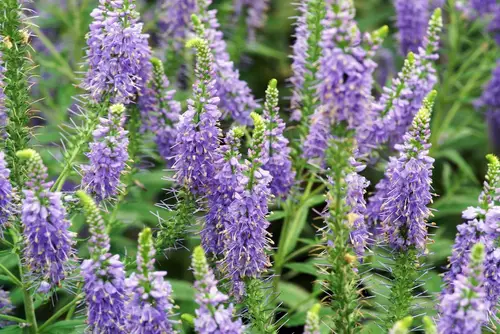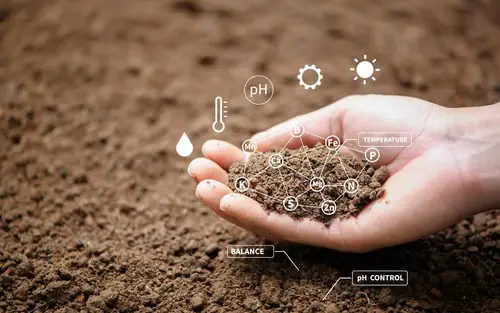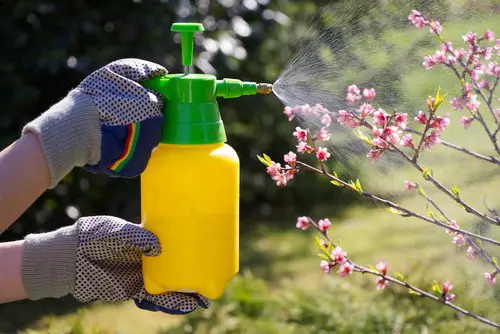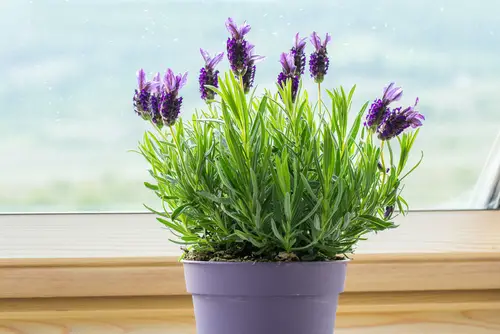Lavender is a popular plant known for its fragrant aroma and beautiful purple blooms. However, if you notice your lavender leaves turning yellow, it can be a cause for concern. Yellowing leaves can indicate that your lavender plant is experiencing stress or disease, and it’s important to identify the cause and take appropriate action.
Understanding lavender plants is key to identifying yellowing symptoms. Lavender plants require specific growing conditions, including well-draining soil, full sun, and minimal watering. When these conditions are not met, it can lead to stress on the plant and yellowing leaves.
Common causes of yellowing can include over-fertilization, poor soil quality, and excessive moisture. By understanding these causes, you can take steps to prevent and treat yellowing in your lavender plants.
Key Takeaways
- Proper growing conditions are essential for healthy lavender plants.
- Yellowing leaves can indicate stress or disease in lavender plants.
- Identifying the cause of yellowing and taking appropriate action can help revive yellow lavender and prevent future yellowing.
Also don’t miss:
- Why Are My Jasmine Leaves Turning Yellow?
- Why Are My Fuchsia Leaves Turning Yellow?
- Why Are My Eggplant Leaves Turning Yellow?
Understanding Lavender Plants

Lavender is a popular flowering plant that is native to the Mediterranean region, particularly France, Spain, and Italy. It is well-known for its beautiful purple or blue flowers and its unique aroma. Lavender is a member of the mint family and is considered an herb due to its culinary and medicinal uses.
Lavender plants are drought-tolerant and prefer dry, well-draining soil. They thrive in full sun and can grow up to 2-3 feet tall. Lavender plants are commonly grown for their fragrance and are often used in perfumes, soaps, and other personal care products.
The leaves of lavender plants are narrow and gray-green in color. They are covered in small hairs that give the plant a fuzzy texture. The flowers of lavender plants are usually purple or blue, but can also be pink or white. They bloom in the summer and fall and are highly attractive to bees and other pollinators.
Lavender plants are a great addition to any garden or landscape, and can be grown in pots or containers as well. They are relatively easy to care for and require minimal maintenance. However, like any plant, they can be susceptible to certain problems, such as yellowing leaves.
If your lavender plant’s leaves are turning yellow, it could be a sign of stress or disease. Some of the most common reasons for yellowing leaves include overwatering, poor soil quality, and nutrient deficiencies. It is important to identify the underlying cause of the problem in order to properly treat it and prevent further damage to the plant.
Identifying Yellowing Symptoms
Lavender is a beautiful and fragrant plant that can add a touch of elegance to any garden or home. However, if you notice yellowing symptoms on your lavender leaves, it can be a sign that something is wrong. Here are some common yellowing symptoms to look out for:
- Yellow Leaves: One of the most obvious signs of a problem with your lavender plant is yellow leaves. The yellowing may start at the tips or edges of the leaves and spread throughout the entire leaf.
- Drooping Appearance: Another symptom of a diseased/dying plant is a drooping appearance. The plant may look wilted and lifeless, and the flowers may be few and far between.
- Yellow Foliage: If the entire plant is turning yellow, it may be a sign of a more serious issue. Yellow foliage can indicate a nutrient deficiency, root rot, or a fungal disease.
- Dying Plant: If the yellowing symptoms are left untreated, the plant may eventually die. It is important to identify the problem early and take action to save the plant.
Lavender Leaves Turning Yellow – 5 Common Problems
Lavender is a popular and hardy plant that is known for its fragrant flowers and its ability to thrive in a variety of climates. However, if you notice that the leaves of your lavender plant are turning yellow, it can be a sign that something is not quite right. Here are some common causes of yellowing lavender leaves:
1. Overwatering

One of the most common causes of yellowing lavender leaves is overwatering. Lavender is a drought-tolerant plant that prefers well-draining soil.
If the soil is too moist, the roots may become waterlogged and begin to rot, which can cause the leaves to turn yellow. To prevent overwatering, make sure the soil is completely dry before watering again.
2. Lack of Sunlight
Lavender plants require at least six hours of direct sunlight each day to thrive. If your lavender plant is not getting enough sunlight, the leaves may turn yellow and the plant may become weak and spindly. To prevent this, make sure your lavender plant is located in a spot that receives plenty of sunlight.
3. Nutrient Deficiencies
Lavender plants require certain nutrients, such as nitrogen, phosphorus, and potassium, to grow and thrive. If your lavender plant is not getting enough of these nutrients, the leaves may turn yellow and the plant may become weak and stunted.
To prevent nutrient deficiencies, make sure your lavender plant is fertilized regularly with a balanced fertilizer.
4. Stress
Lavender plants can become stressed for a variety of reasons, such as extreme temperatures, high humidity, or lack of water. When a plant is stressed, it may begin to drop leaves or turn yellow. To prevent stress, make sure your lavender plant is located in a spot with consistent temperatures, and water it regularly.
5. Fungal Diseases
Lavender plants are susceptible to a variety of fungal diseases, such as root rot and leaf spot. These diseases can cause the leaves to turn yellow and eventually fall off. To prevent fungal diseases, make sure your lavender plant is located in a spot with good air circulation, and avoid overwatering.
Role of Soil and Drainage
Lavenders require well-draining soil to thrive. If the soil around the lavender plant is too wet or doesn’t drain well, it can cause the leaves to turn yellow. Overwatering or watering too frequently can lead to slow drainage, which can cause root rot and other fungal diseases in the plant.
Lavenders prefer sandy soil with a pH level between 6.5 and 7.5. Sandy soils are well-draining and can prevent waterlogging around the roots. If the soil is compacted or too rich in nutrients, it can also cause the leaves to turn yellow.
If the soil is too alkaline or too acidic, it can also affect the plant’s growth and cause yellowing of leaves. Lavenders prefer slightly alkaline soil, so if the soil is too acidic, it is recommended to amend the soil with organic matter or compost to adjust the pH level.
It is important to ensure that the lavender plant is planted in the correct soil type. If the soil is incorrect, it can cause the plant to struggle and lead to yellowing of leaves. Adding stones or pebbles to the soil can also improve drainage and prevent waterlogging.
If the soil around the lavender plant is slow-draining, it is recommended to plant it in a raised bed with fast drainage or add drainage holes to the pot. This will ensure that the water flows freely and does not accumulate around the roots.
The Impact of Over Fertilizing

Over fertilizing is a common cause of yellowing lavender leaves. Lavender plants require a balanced amount of nutrients to thrive, and over fertilizing can lead to an excess of nutrients, particularly nitrogen, in the soil. This can cause the lavender to grow too quickly, leading to leggy and untidy plants with yellowing foliage.
Excessive nitrogen in the soil can also lead to a reduction in the number of flowers produced by the lavender plant. This is because the plant will focus on growing foliage rather than producing blooms.
It is important to note that over fertilizing can be caused by both organic and synthetic fertilizers. Manure, compost, and other organic fertilizers can also contain high levels of nitrogen and lead to similar issues.
To avoid over fertilizing, it is recommended to use a slow-release fertilizer specifically designed for lavender plants. These fertilizers are formulated to release nutrients gradually, providing the plant with a steady supply of nutrients over time.
It is also important to follow the recommended application rates for the fertilizer. Over fertilizing can occur when too much fertilizer is applied, even if it is a slow-release fertilizer.
Pot and Transplant Considerations
When it comes to potted lavender, the pot and transplant considerations are crucial. If the pot is too small, the roots of the lavender plant may become cramped and hinder its growth, which can lead to yellowing leaves. Therefore, it is important to choose an appropriate pot size that allows the lavender roots to spread out and grow freely.
Transplanting lavender can also cause stress to the plant, which can lead to yellowing leaves. It is recommended to transplant lavender in the spring or fall when the temperatures are mild. Additionally, it is important to choose a location with adequate sunlight and well-draining soil.
Inappropriate pots can also cause yellowing leaves in potted lavenders. Lavenders require well-draining soil, and if the pot does not have proper drainage holes, excess water can accumulate in the soil and cause root rot, which can lead to yellowing leaves.
Therefore, it is important to choose a pot with adequate drainage holes to prevent water accumulation.
Reviving Yellow Lavender
Yellowing of lavender leaves is a common issue, but it can be revived with proper care. The first step is to identify the issue causing the yellowing leaves. Once the issue is identified, it’s easier to take the necessary steps to revive the plant. Here are some tips to revive yellow lavender:
1. Pruning
Pruning is an essential step in reviving yellow lavender. Pruning helps to remove dead or diseased parts of the plant, which can improve the plant’s health. Use pruners to cut back the yellowing parts of the plant, leaving only the healthy parts. Be sure to sterilize the pruners with rubbing alcohol to prevent the spread of disease.
2. Identify the Issue
Yellowing of lavender leaves can be caused by several factors, including overwatering, too much nitrogen, unsuited soil, high humidity, and fungal disease. Identify the issue and take the necessary steps to fix it.
For example, if the issue is overwatering, reduce the frequency of watering. If the issue is too much nitrogen, avoid using nitrogen-rich fertilizers.
3. Soil

Lavender requires well-draining soil with a pH between 6.5 and 7.5. If the soil is too acidic or too alkaline, the plant may experience yellowing of leaves. Test the soil pH and adjust it accordingly. Also, avoid using nitrogen-rich fertilizers, as they can cause yellowing of leaves.
4. Watering
Overwatering can cause yellowing of lavender leaves. Water the plant only when the top inch of soil is dry. Also, avoid watering the plant from above, as it can cause fungal diseases. Instead, water the plant at the base.
Preventing Yellow Leaves in Lavender
Lavender is a beautiful and fragrant plant that can add a touch of elegance to any garden or landscape. However, yellow leaves in lavender can be a common problem that gardeners face. Here are some tips to help prevent yellow leaves in lavender:
1. Plant Lavender in the Right Season
Lavender is a hardy plant that can thrive in various seasons. However, it is best to plant lavender during the spring or fall when the temperature is cooler. Planting lavender during the hot summer months can cause stress to the plant, which can lead to yellow leaves.
2. Provide Adequate Sunlight
Lavender requires at least 6 hours of direct sunlight per day to thrive. Make sure to plant lavender in an area that receives enough sunlight. If the plant is not getting enough sunlight, it can cause the foliage to turn yellow.
3. Prevent Leggy Lavender
Leggy lavender can be a common problem that can lead to yellow leaves. Leggy lavender occurs when the plant becomes too tall and spindly. To prevent leggy lavender, pinch back the tips of the plant regularly to encourage bushier growth.
4. Provide Adequate Airflow
Lavender requires adequate airflow to prevent moisture buildup, which can lead to fungal diseases. Make sure to space out lavender plants properly to allow for adequate airflow.
5. Use Fungicide

Fungal diseases can cause yellow leaves in lavender. To prevent fungal diseases, use a fungicide on the plant regularly. Make sure to follow the instructions on the fungicide label.
6. Avoid Overwatering
Overwatering can cause yellow leaves in lavender. Make sure to water the plant only when the soil is dry to the touch. Avoid watering the plant too much, as it can cause root rot, which can lead to yellow leaves.
7. Maintain a Healthy Lawn and Yard
A healthy lawn and yard can help prevent yellow leaves in lavender. Make sure to remove any dead leaves or debris from the lawn or yard regularly. Dead leaves and debris can harbor fungal diseases, which can spread to lavender plants.
Frequently Asked Questions
How do you revive dying lavender plants?
Reviving a dying lavender plant depends on the cause of the problem. If the plant is overwatered, then it is best to reduce watering and ensure that the soil is well-draining. If the plant is underwatered, then it needs to be watered more frequently.
If there is root rot, then the plant needs to be repotted in fresh soil. Pruning back the plant can also help stimulate new growth.
What does it mean when lavender leaves turn brown?
Brown leaves on lavender plants can be a sign of several issues. It could be due to overwatering, root rot, fungal disease, or insect infestation. Pruning back the plant and improving drainage can help prevent further damage.
What are the signs of overwatered lavender?
Overwatered lavender plants may have yellowing leaves, a droopy appearance, and a musty smell. The soil may also be waterlogged, and the roots may be rotting. It is important to reduce watering and improve drainage to prevent further damage.
Why is my lavender yellowing at the base?
Yellowing at the base of the lavender plant may be due to root rot or fungal disease. It is important to improve drainage and ensure that the soil is well-draining. Pruning back the plant can also help stimulate new growth.
What does yellow lavender signify?
Yellowing lavender plants can signify several issues, including overwatering, nutrient deficiencies, fungal disease, insect infestation, or root rot. It is important to identify the cause and address it promptly to prevent further damage.
How do you properly prune lavender plants?
To properly prune lavender plants, it is best to wait until after the first bloom and then cut back the stems to just above the woody part of the plant.
This will help stimulate new growth and prevent the plant from becoming too woody. It is important to avoid cutting into the woody part of the plant, as this can cause damage and prevent new growth.

Hey, I’m Lisa and I’ve been an avid gardener for over 30 years. I love writing, talking and living in the garden! Feel free to connect with me on my socials below


